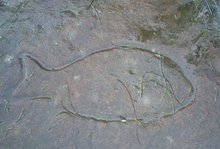 Salmonella has been found in sand of playgrounds in Mona Vale, Winnererremy Bay, Warriewood, Palm Beach and North Avalon. One year on and the bacteria (Salmonella paratyphi bio var java) have resurfaced in the sand. In Dunbar Park, which is now closed the sand will be replaced with 'treated bark'. Both in May 08 and November 08 Mnly wrote about the connections between(exotic) pets, fecal contamination and aggregation of minors in beach sand.
Salmonella has been found in sand of playgrounds in Mona Vale, Winnererremy Bay, Warriewood, Palm Beach and North Avalon. One year on and the bacteria (Salmonella paratyphi bio var java) have resurfaced in the sand. In Dunbar Park, which is now closed the sand will be replaced with 'treated bark'. Both in May 08 and November 08 Mnly wrote about the connections between(exotic) pets, fecal contamination and aggregation of minors in beach sand.
New research has also found that people digging in beach sand or building sandcastles risk gastrointestinal diseases and diarrhea. The epidemiological study looked into sand contact activities and illnesses.
"Researchers found evidence of gastrointestinal illnesses, upper respiratory illnesses, rash, eye ailments, earache and infected cuts. Diarrhea and other gastrointestinal illnesses were more common in about 13 percent of people who reported digging in sand, and in about 23 percent of those who reported being buried in sand...We have known for some time that swimming in waters polluted by fecal contamination can result in illness, but few previous studies have focused on sand."
Beach users should use a hand sanitizer or wash their hands/body after contacting beach sand.
The runoff from urinating and defecating dogs at the beach promenade/wall, draining through the pvc pipes/stairs onto the beach sand does not seem to make the beach sand less risky.
 Questions remain:
Questions remain:
Where was the sand sourced from that covered the playgrounds?
Where can information be obtained regarding fecal contamination of beach sand at Manly Beach?
Links
Sand, salmonella, e-coli and that cute pet, May 08
More salmonella mysteries on the Northern Beaches, November 08
University of North Carolina at Chapel Hill (2009, July 10). Digging In Beach Sand Increases Risk Of Gastrointestinal Illness. Via ScienceDaily
Christopher D. Heaney et al., Contact With Beach Sand Among Beachgoers and Risk of Illness, American Journal of Epidemiology Advance Access published on June 18, 2009, Am. J. Epidemiol. 2009 170: 164-172; doi:10.1093/aje/kwp152
17 July 2009
Beach Sand, Fecal Contamination and Salmonella
Tags
disease,
dog_owners,
health,
Manly_beach,
risk_society,
sand,
waste,
young_people
Subscribe to:
Post Comments (Atom)











No comments:
Post a Comment